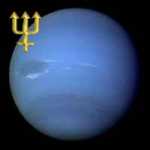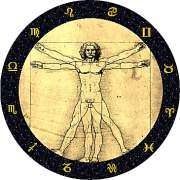Weboteric - Astrology
|
 |

Astrology - Neptune
Ruler of the Seas
Oh blessed one, be kindly in heart and help those who voyage in ships! - Homer.
Its symbol can be taken as an upward extension of the cross of matter shielded by a crescent of receptivity, although based on the trident of Neptune.
Mythology
Poseidon was the god of the sea in Greek mythology.
The son of Cronus and Rhea, and the brother of Zeus and Hades. Poseidon and the Gorgon Medusa were the parents of Pegasus, the famous winged horse.
Poseidon is represented as a bearded and majestic figure, holding a trident and often accompanied by a dolphin.
Every two years the Isthmian Games, featuring horse and chariot racers, were held in his honor at Corinth.
The Romans identified Poseidon with their god of the sea, Neptune whose festival was in July.
Poseidon was commonly called the earth shaker and the earth encircler in The Iliad and The Odyssey of Homer.
Effects of Neptune
Second of the Modern planets - those discovered in modern times and not seen with the naked eye.
From an astrological point of view, little is known about the trans-Saturnians or 'modern' planets. Therefore, they are considered with caution and secondary to the seven traditional planets.
Following their discovery, modern astrologers have often tried to include
them into the traditional scheme but opinion is mixed about their effect
and if they should be included into calculation at all.
Astrology always has been a geocentrically based system about how the heavens
appear to us on Earth, not about how they are in astronomical reality. Therefore,
since these planets can't be seen with the naked eye, would they have been
accepted into the scheme had the ancients known about them?
The philosophy of astrology has always been about understanding 'As Above,
So Below' with emphasis on arbitrarily defined constellations. Yet the mystery
of why separate cultures divided by time and distance should all arrive
at twelve signs of the zodiac (even if named and shaped differently) remains.
However, it would be wrong to discount them entirely, although in most cases
they seem to achieve little more than add to the traditional planets' effects.
As Neptune takes 165 years to go around the Sun, this planet will be in any one sign for a period of about 14 years. Its influence is therefore experienced most strongly as long-term collective changes. Neptune's sign position shows the collective need to transcend from the everyday life through the media, films and visionary ideals and has been found to represent non-material influences like dreams and illusions. It brings dissolution of structures and represents idealistic drives - both on a social and a spiritual level. Neptune opens the door to the divine, leaving residual discontent about mundane existence.
How Neptune will manifest its energy will depends on the horoscope as a whole. The Sign (and its Element), the House in which it falls, and the Aspects to the other planets will all have a bearing on any interpretation.
On a personal level Neptune shows where specifically you will feel the need to transcend, where dreams are built up and dissolve and in what area of life you gain spiritual understanding through acceptance of the transience of all things.
Neptune's action is considered to be that of loosening, dissolving boundaries, expanding and distorting and it represents Intuition, Idealism, Self-sacrifice, Glamour, Illusion and Decay.
Neptune Key Facts |
|
Rules: |
|
Detriment: |
|
Exhalt: |
|
Fall: |
|
Colours: |
Lavender, sea green and blue |
Stones & Metals: |
Coral, aquamarine, platinum and neptunium |
Keywords: |
The dreamer and the great deceiver |
Astronomy
Neptune is the eighth planet from the Sun and the fourth largest (by diameter). Neptune is smaller in diameter but larger in mass than Uranus.
After the discovery of Uranus, it was noticed that its orbit was not as it should be in accordance with Newton's laws. It was therefore predicted that another more distant planet must be perturbing Uranus' orbit. Neptune was first observed by Galle and d'Arrest on 1846 Sept 23 very near to the locations independently predicted by Adams and Le Verrier from calculations based on the observed positions of Jupiter, Saturn and Uranus.
An international dispute arose between the English and French (though not, apparently between Adams and Le Verrier personally) over priority and the right to name the new planet; they are now jointly credited with Neptune's discovery.
Subsequent observations have shown that the orbits calculated by Adams and Le Verrier diverge from Neptune's actual orbit fairly quickly. Had the search for the planet taken place a few years earlier or later it would not have been found anywhere near the predicted location.
Because Pluto's orbit is so eccentric, it sometimes crosses the orbit of Neptune. For twenty years from 1979 Neptune was actually the most distant planet from the Sun - Pluto returned to the depths in 1999.
Daylength (rotation) |
16 Hours |
|||||||||||||||||||||||||||
Year length |
164.79 Years |
|||||||||||||||||||||||||||
Distance from the sun (average) |
2,799 million miles (4,504 Million KM) |
|||||||||||||||||||||||||||
Distance from Earth (shortest) |
2,680 million miles (4,313 Million KM) |
|||||||||||||||||||||||||||
Distance from Earth (greatest) |
2,910 million miles (4,683 Million KM) |
|||||||||||||||||||||||||||
Size (Earth=1) |
3.88 |
|||||||||||||||||||||||||||
Mass (Earth=1) |
17.2 |
|||||||||||||||||||||||||||
Moons |
|


Copyright © Weboteric.com 2006 Webdesign by WebOneUK